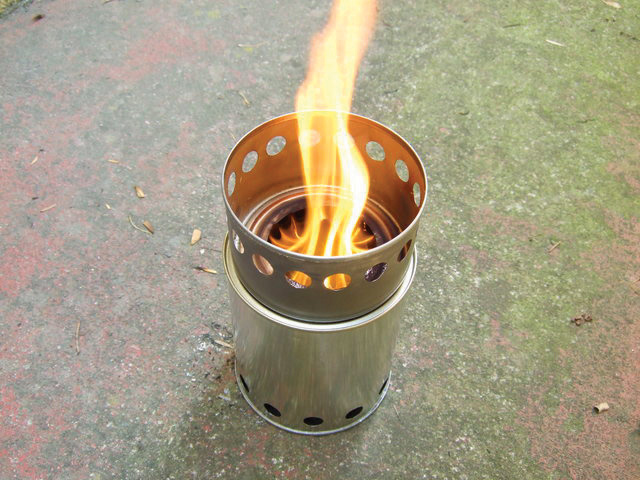Nearly half the world’s population cooks and heats using solid fuel, much of it burning up in pits that have seen no improvement since Homo erectus first tamed fire.
This is not a small problem: inefficient cooking fires waste fuel, impoverishing both the planet and the person burning it; they inject startling quantities of soot, carbon dioxide, and worse greenhouse gases into the atmosphere; and they injure and kill the families who use them to cook and stay warm.
You can build a simple example of an appropriate technology that addresses all these problems: a biomass gasifier camp stove. It sounds more complicated than it is. Charring wood or other natural solid fuels releases gases that burn quite nicely. If you’ve ever watched a campfire closely, you’ve seen little jets of smoke erupt from the wood ahead of the flame. If conditions are perfect, a smoke jet catches fire and turns, briefly, into a tiny geyser of flame. A good gasification stove recreates these conditions reliably, generating smoke and moving air to produce these little fire geysers on demand.
There are many designs for efficient camp stoves, and gasification is only one way to boost the efficiency of a cooking fire. The wood gas stove in this article is an elegantly simple gasifier design called a TLUD stove (for top-lit updraft), also known as an inverted downdraft stove. If you don’t care how it looks, you can build it with a can opener, a punch, and a big rock. This design, which I’ve adapted from one I first saw on Instructables, is built around a 1-quart paint can. It easily boils enough water for a small pot of tea or a bowl of noodles, using nothing more than a fist-sized charge of scrap wood.
How It Works
This TLUD camp stove works in batches: fill it up with twigs and woody bits, and light it from the top. As the fire burns, it makes a layer of hot coals, and as this burning mass descends into the can, it becomes starved for air. Enough oxygen comes up from below to keep the embers alight, but not enough to sustain a flame.
This charring layer slowly descends, releasing flammable gases as it goes — a process called pyrolysis. The hot gases rise to the top of the camp stove, where they are met by an inrush of preheated air and, if all goes well, combine completely with this air in a clean secondary burn that consumes the methane, soot, and carbon monoxide produced by the primary combustion.
When a TLUD is dialed in, it’s lovely: a layer of smoke hangs over the coal bed like a fog, and appears imprisoned by a gauntlet of inward-facing flame jets that rush in from the edges of the stove. While the stove is gasifying, it’s remarkably clean: there’s little or no smoke and only a faint odor, reminiscent of diesel or creosote. It leaves a trace of soot on your pot, compared to the heavy blackening an open fire imparts. And when your camp stove is done gasifying and the flame jets go out, clean charcoal remains in the stove.
This residual charcoal is a fringe benefit: not only can you use it for gunpowder (see MAKE Volume 13, page 54), but you can cook with it a second time in a clean-burning charcoal fire. You can also throw it into your compost and bury it. Called biochar, this buried charcoal enriches the soil and actually makes your carbon-neutral biomass fuel carbon-negative.
WARNINGS!
- This camp stove produces and consumes carbon monoxide, a deadly poison. DO NOT EXPERIMENT WITH THIS STOVE INDOORS! Use it only outdoors.
- Your stove will get hot. Using it on a wooden bench will leave a scorch mark. Use it on concrete, a tile you don’t care for (thermal shock may crack it), or on dirt you don’t mind scorching.



